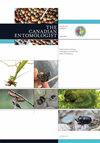豆娘Gregarine感染与湿地类型及景观特征的关系
IF 1.1
4区 农林科学
Q3 ENTOMOLOGY
引用次数: 10
摘要
虽然人类改造景观的特点是自然栖息地的丧失,但新的栖息地也可以被许多物种创造和利用。景观变化对无脊椎动物群落(特别是宿主-寄生虫群落)的重要性还未得到充分研究。本研究的目的是确定17个人工湿地和7个自然湿地中豆蝇(Ischnura verticalis)的寄生率和强度是否存在差异,这些湿地在距离每个湿地500 m和1 km的空间范围内具有不同的森林和湿地覆盖量以及道路密度。湿地位于加拿大安大略省的渥太华和魁北克省的加蒂诺及其周围。湿地类型对森林、湿地覆盖和道路密度主成分的影响均不显著。在自然湿地收集的豆豆蝇中,豆豆蝇的Gregarine患病率高于在人工湿地收集的豆豆蝇,并与森林覆盖的增加呈正相关。相反,格林强度与道路密度呈负相关。我们的研究结果表明,豆娘寄生与湿地类型和景观特征有关,尽管产生这种关系的机制尚不清楚。本文章由计算机程序翻译,如有差异,请以英文原文为准。
Relationships Between Gregarine Infection in Damselflies, Wetland Type, and Landscape Characteristics
Abstract
Although human-modified landscapes are characterized by the loss of natural habitats, new habitats also can be created and exploited by many species. The importance of landscape change to invertebrate associations (particularly host-parasite associations) is under-studied. Our objective was to determine whether prevalence and intensity of gregarine parasitism in the damselfly Ischnura verticalis (Say) (Odonata: Coenagrionidae) differed between 17 artificial and 7 natural wetlands in landscapes that varied in amount of forest and wetland cover and road density determined at spatial extents of 500 m and 1 km from each wetland. Wetlands were located in and around Ottawa, Ontario, and Gatineau, Quebec, Canada. Wetland type did not account for significant variation in principal components based on forest and wetland cover and road density at either spatial extent. Gregarine prevalence was higher in damselflies collected from natural wetlands than in those collected from artificial wetlands and was positively associated with increasing forest cover. In contrast, gregarine intensity was inversely related to road density. Our results suggest that parasitism of damselflies by gregarines is associated with wetland type and landscape characteristics, although the mechanisms producing such relationships are unknown.
求助全文
通过发布文献求助,成功后即可免费获取论文全文。
去求助
来源期刊

Canadian Entomologist
生物-昆虫学
CiteScore
2.20
自引率
11.10%
发文量
24
审稿时长
6-12 weeks
期刊介绍:
French translation follows/le français suit Published since 1868, this peer-reviewed bimonthly publication is the official journal of the Entomological Society of Canada. Available via the internet and with hardcopy distribution to 55 countries, its research papers and notes are relevant to entomologists and other biologists around the world. In addition to being a venue for topical reviews and forum discussion, The Canadian Entomologist publishes current research in all facets of entomology, including systematics and morphology, molecular and developmental biology, ecology and behaviour, biodiversity and evolution, insect management, entomological techniques, and other relevant subject areas. Contributions are published in English or French. Authors will not pay page charges, and will experience fast, high quality reviews of their papers.Publiée depuis 1868, cette publication bimestrielle avec comité de lecture est la revue officielle de la Société d’entomologie du Canada. Disponible sur Internet et distribuée en format papier dans 55 pays, ses articles de recherche et ses notes sont pertinents pour les entomologistes et autres biologistes de par le monde. En plus d’être une plate-forme pour des revues thématiques et un forum de discussion, The Canadian Entomologist publie la recherche actuelle sur toutes les facettes de l’entomologie, incluant la systématique et la morphologie, la biologie moléculaire et développementale, l’écologie et le comportement, la biodiversité et l’évolution, la gestion des insectes, les techniques entomologiques et d’autres domaines pertinents. Les contributions sont publiées en français ou en anglais. Les auteurs ne paient aucun frais de publication, et recevront une révision rapide et de grande qualité de leurs articles.
 求助内容:
求助内容: 应助结果提醒方式:
应助结果提醒方式:


